|
FAQs on Freshwater Stingray
Disease/Health 2
FAQs on FW Stingray Disease:
FW Stingray Disease 1,
FW Stingray Disease 3,
FW Stingray Disease 4,
FAQs on FW Stingray Disease by Category:
Diagnosis,
Environment, Nutrition,
Trauma,
Infectious
(Virus, Bacterial, Fungal),
Parasitic,
Social,
Treatments
Related Articles:
Freshwater Stingrays,
Related FAQs: Freshwater Stingrays,
FW Stingray Identification,
FW Stingray Behavior,
FW Stingray Compatibility,
FW Stingray Selection,
FW Stingray Systems,
FW Stingray Feeding,
FW Stingray Reproduction,
|
|
Motoro stingrays 11/23/14
I just recently purchased two Motoro stingrays my one has a red
spot on the underside and they did look like they were shedding
but that has stopped. But now they are inactive and just sitting in the
bottom.
Is there something wrong? Please Help
<Going to direct you to some reading first:
http://www.wetwebmedia.com/fwsubwebindex/fwraydisfaqs.htm
http://www.wetwebmedia.com/fwsubwebindex/fwraysysfaqs.htm
Stingrays of all types are EXTREMELY sensitive fish. They need giant
tanks, big filters, and keepers for whom money is no object. Not kidding
here.
Without any information about your system I really can't pin down the
immediate problem. Stingrays almost always get sick because of
environmental shortcomings -- the tank is too small, there isn't enough
filtration, there's too much nitrate, that sort of thing. Minor injuries
actually heal rather well if the environment is good, so a small
"bruise" isn't necessarily a disaster if you have the right environment
(by which I mean a 200+ gallon tank, several massive external filters,
and frequent water changes that keep nitrate below 20 mg/l). On the
other hand, once bacteria set into a wound and start an infection,
treatment is EXTREMELY difficult. Most fish medications are lethal to
them. Forget about popping down to the aquarium shop and buying a bottle
of something cheap and cheerful. Such products often contain copper and
formalin, and these are deadly to Stingrays. Treatment to injuries is
pretty much limited to ensuring optimal environmental conditions,
offering a varied diet (no feeder fish, EVER), and waiting for the fish
to heal itself. Even if you contact a vet and obtain the right
antibiotics (randomly treating with aquarium shop antibiotics is a bit
hit-and-miss with Stingrays) and dose
the antibiotics properly (essentially impossible for casual aquarists
because they don't know the weight of their fish) there isn't any sort
of guarantee the Stingray will heal. So again, to stress, your two new
Stingrays are certainly stressed from being moved (they often shed some
mucous when exposed to sudden changes, even normal water changes) and
quite possibly injured, neither of which you can do much about. But now
they're in your aquarium, you absolutely must ensure they have a perfect
(not "quite good" or "pretty sweet", but "perfect") aquarium for them.
Two specimens will need a massive amount of water, shall we say 300
gallons for a pair of adults? Maybe 200 gallons for a couple youngsters
up to a disc width of, say, 20 cm/8 inches. Filtration rated at around 8
times the volume of the tank in gallons per hour turnover, so for a 200
gallon tank, upwards of 1600 gallons/hour (which is equivalent to SIX
Eheim 2217
canister filters, or even ONE-AND-A-HALF times the turnover of the
gigantic Fluval FX6 which is why Stingray keepers usually end up using
marine-grade filters with big pumps and crates of media in a sump under
the tank).
Hmm... does this help? Oh, and do rush and buy Richard Ross' book on
keeping Stingrays. Essential reading. Cheers, Neale.>
|
Freshwater Stingray Disease - Open Sores Spreading Rapidly
10/31/14
Good afternoon
<Wayne... 8 Megs of pix?>
First off, I would like to thank you for taking the time to read my
email and helping so many others with our
baffling questions.
<You'd do the same, given similar circumstances as ourselves>
I have a Freshwater Hybrid stingray (Marble and Motoro) and she's
approximately 11 inches. I've had her for awhile now and just
recently I introduced some Java Moss to the
tank. This plant was purchased online and
I introduced it to the tank without treating the plants first of any
diseases. After a couple days, one of my fishes dies and I didn't
think much of it (this fish had been bullied
and not eating for awhile). That same week I
noticed what looks like a burn mark on the bottom of my ray.
The skin appears to be whitefish with dots of blood....and it looks like
it's healing by itself.
<... petecchia... This symptom can be due to a few causes.
Potamotrygonids don't "like" metabolite build-up... poor water quality.
This is my first guess... what sort of NO3 here?>
I went out of town for a couple days and noticed this mark begins to
spread to other parts of the stingrays
underside. I immediately put the stingray
into a quarantine tank and began treating it
with half the recommended
amount of aquarium salt and the full dosage of MelaFix.
<... ridiculous. SEE WWM RE>
My water parameters are all within range as I
diligently perform water changes and have it
tested.
<Of no use to us... WHAT are the readings?>
I've been treating my ray for approximately 5 days now and it still
doesn't appear to be getting any better.
<It'll soon be dead from the Melaleuca exposure>
I hate to say it, but it looks like it's some
kind of flesh eating bacteria as some parts of my ray's skin is
getting so thin I can see the outline of the skeleton. Furthermore,
wherever the infection is, the ray's skin is peeling off as I can
see the dead skin hanging off.
Also, the stingray's quarantine tank is very cloudy and I think this is
caused by the shedding and peeling of the ray's skin.
<... the scam API product>
I don't have any filter pads in the tank right
now because I'm using Melafix. However, I
perform 25% water changes every day hoping that it will help the
visibility of my tank but it does not.
<REMOVE the "fix", restore filtration, esp. biological NOW>
And finally, my ray still looks very healthy and has an appetite. I fed
it twice in the quarantine tank, but I'm
trying to limit the feeding until she gets
better.
Please take a look at my pictures and let me know what you think. Thank
you
*Wayne*
<"Bob" Fenner>
|
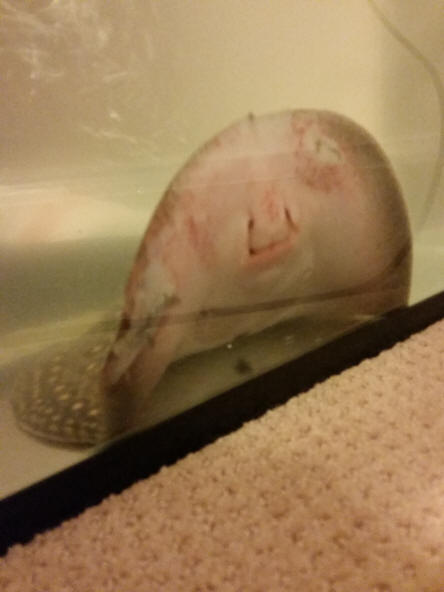 |
Motoro Ray Problem 5/22/14
Hi, I just stumbled across your website and
was wondering if you've ever seen the back of a stingray bubble
up like a boil? I work at a pet store and our ray tank has kept
rays alive for months before selling them and we usually sell them in
better shape than when we got them. I don't have any specific water
tests I can tell you but I'll explain the best I can. There are 5 rays
in our ray tank, when I left work Monday at 2pm everything was fine. I
came to work noon on Wednesday and one Motoro had probably ~15-20% of
its back boiled up like a air/fluid filled sack. It deflated and
refilled and deflated and refilled, then it popped and it was dead no
less than an hour later. Any ideas of what can cause the skin to bubble
up and kill so quickly?
Thanks,
Aaron
<Aaron, there is something called "Gas Bubble Disease"
that can happen when the water is supersaturated with (for example)
oxygen. Extremely strong filtration alongside a lot of turbulence can
cause a higher than normal amount of gases from the air to get dissolved
in the water. This isn't often seen in freshwater systems but was/is
more common in marine systems and ponds where there's often a lot more
air/water mixing, e.g., by waterfalls, fountains, wet/dry filters,
skimmers, etc. Very cold water can hold more oxygen than warmer water,
which is one reason it's dangerous to add a lot of very cold water to an
aquarium or pond because of this.
Anyway, the dissolved gases go into the fish, but then bubble out,
damaging the surrounding tissues. With this said, Gas Bubble Disease is
rare, and most bubble-like cysts or pockets on aquarium fish are caused
by the release of gas by bacteria, usually opportunistic ones that have
infected a wound. While you can't be 100% sure, if the bubble on the
Stingray was associated with any red or white patches, and especially if
there are lots of bubbles on one fish but none on the others, you can
probably put your money on a bacterial infection. Since Stingrays are
sensitive to all sorts of environmental stresses as well as the usual
aquarium pathogens, you will doubtless have a long list of things to
review before considering this case closed! Hope this helps, Neale.>
Fungus on Reticulated Stingray
8/8/13
Picked up new pair of Reticulated (Teacup) Stingrays, the female
developed a small fungus on the barb. There were no caps used at the LFS
they were purchased from, however it could have already been there just
unnoticed when purchased.
They are currently in a 55 gallon quarantine tank, once fungus is
removed they will be moved into a 225 gal with a fx5 canister and 55
gallon sump.
My question is, how to treat this fungus outbreak? I've done what I feel
to be inferior research, even though its been extensive. I've never
owned rays before this. I started a Pimafix regime, read online it was
ray safe. Been 4 days and there has been no improvement visible to the
naked eye. Can I continue usage and add salt? Should I finish the week
of Pimafix, and if not better try salt?
What are your recommendations?
Thank you for your time, hopefully you can help me,
Devin
<Hi Devin. Since you're keeping stingrays, money is presumably no
object, as you already (hopefully) know that these fish are very
expensive to keep well. Basically, prevention is 99% of what you can do
so far as stingray health goes. Once they're sick, then you really can't
rely on anything bought from an aquarium shop -- including Pimafix. On
the plus side, if you can get these fish into optimal conditions
immediately, and by that I mean your 200+ gallon system (with mature
filter, naturally) then your stingray may well heal spontaneously.
That's often what happens with very minor wounds. Paradoxically, most
fungal infections happen secondarily to bacterial infections, so the
recommended treatment (e.g., by Richard Ross, whose book/s you must
surely have read) is injectable antibiotics that get rid of bacterial
infection so the fungal infection can fade away. That's where the money
no object aspect comes in. Call a vet specialising in fish, because
you'll need reliable advice here. Obviously you can't randomly add
antibiotics to the water because these have the real potential to cause
stingrays harm. Again, Richard Ross goes into all this. You can't use
traditional medications like Methylene Blue or Malachite Green either as
these tend to be quickly toxic to stingrays. As for Pimafix and Melafix,
some folks have used them successfully, others find they do more harm
than good (WWM owner Bob Fenner for one), and as a very general comment,
time wasted with these sometimes-useful, sometimes-harmful medications
is time you could have used something with a much higher probability of
working at less risk, so on that basis alone I'd skip them. The use of
salt is an interesting idea. The Potamotrygonidae have some tolerance
for salt, likely given their marine ancestry, as evidenced by laboratory
work as well as
aquarium hear-say, so in itself it shouldn't cause any undue harm to
these strictly freshwater rays. Salt can and does slow down the spread
of fungal infections (though rarely bacterial infections) and may
provide some degree of support to a fish with an otherwise functional
immune system that can drive off a mild infection given that little
extra help. But salt is rarely a "silver bullet" in itself, so do review
aquarium environmental conditions and any potentially damaging objects
in the tank (including tankmates), and act accordingly. But as I say
above, at the end of the day calling a qualified vet is the best/only
reliable approach for medicating stingrays, and something you presumably
budgeted for before purchase, so the minor expense shouldn't phase you
(and in any case, will be trivially small compared to the cost of those
thousands of gallons of reverse-osmosis water you're going to be getting
though during water changes every year!). Hope this helps, Neale.>
Re: Fungus on Reticulated Stingray (Bob, is Pimafix/Melafix useful on
Elasmobranchs?)<<Is not. RMF>>
Neale,
Without explaining too much into detail, lets just say the area I'm
located isn't... stingray friendly.
<Understood.>
So vets aren't an option unfortunately. I may be able to call in a favor
to a friend who works at a aquarium.
<Ah, next best thing. As I said, provided conditions are optimal in the
aquarium, minor wounds can/will heal under their own steam, but if the
infection spreads/shows no sign of clearing up, then treating stingrays
is troublesome. As Bob says in the subject line of this message, Melafix
and Pimafix are not reliably useful when treating this group of
animals.>
Thank you for your time, I appreciate the rapid response.
Devin
<Most welcome. Do also procure Richard Ross' book; will be money well
spent. Cheers, Neale.>
Re: Fungus on Reticulated Stingray (Bob, is Pimafix/Melafix useful on
Elasmobranchs?) 8/8/13
I found a copy of the book, will be purchasing. Didn't know the
literature existed till I found this website.
<Good purchase. Richard Ross is "the man" when it comes to stingrays.>
Again I appreciate your time and your response, I have one more question
for you. Promise, this will be the last.
<No need for promising such; we're happy to help.>
The LFS I purchased the rays from has done their best to help me. I
called them yesterday about possibly procuring some injectable
antibiotics and overnighting them to me, and she didn't know what I was
talking about. I explained to her what you had sent me in previous
emails, and what I had found online (which contradicted her original
treatment plan -Melafix/PimaFix), should sent me an email a few hours
later talking about a treatment called Maracyn 2.
<Yes. Widely sold in the US, not necessarily elsewhere. In any case,
it's simply Minocycline (Maracyn 1, if you're curious, is
Erythromycin,
while Maracyn Plus is Sulfadimidine and Trimethoprim. Both Maracyn 1 and
Maracyn 2 are relatively mild and seem well-tolerated by most/all fish,
and worth a shot, though can't promise anything.>
I looked it up and found some personal reviews by other ray keepers on
monsterfishkeepers.com. Was wondering what your thoughts were before I
might try this treatment is PimaFix and salt prove to be unsuccessful
(as of this morning still no signs of improvement).
<I would rate Maracyn 2 far above Melafix and Pimafix; you can certainly
use the Maracyn 2 alongside salt if needs be.>
The 225 is not quite cycled, or they'd have been moved already, should
be another few days at the least before that tank is ready.
<Sounds like you have a game plan. Good luck, Neale.>
Re: Fungus on Reticulated Stingray (Bob, is Pimafix/Melafix useful on
Elasmobranchs?) 8/8/13
You've been a wonderful help, I appreciate the feedback.
<Glad to help.>
Good news, water tested out last night, tank was cycled. I put the
pair of rays into the tank and fed slightly on the heavy side. Both ate
their fill and I turned the lights off. This morning I went in to check
them, the fungus is completely gone.
<Excellent!>
I'm treating the tank with the Maracyn 2 and some salt to make sure,
keeping it at 50-60% of recommended dosage.
<All sounds very positive.>
But, in regards to your reply, for my knowledge bank, you wrote that
Maracyn 2 is Minocycline, Maracyn 1is Erythromycin, and Maracyn
Plus is Sulfadimidine and Trimethoprim. What is, doesn't have to be well
defined if you can keep it basic, the differences? The Maracyn 2 box
proclaimed to treat bacteria which caused certain ailments, are the
other two for the same?
<Okay, here's the deal. All these are antibiotics. They kill bacteria.
But no *one* antibiotic kills *all* kinds of bacteria. Some kill one
sort well, another a second sort, and so on. Kind of like how the air
force has a dozen kinds of airplanes, but there's no one airplane good
at everything, so depending on the mission, you choose a particular
airplane for the task.
You wouldn't use an F15 for a job where a Hercules would be better, or
vice versa. The tricky bit when choosing which antibiotic to use is that
you cannot say which antibiotic would be ideal without first identifying
the bacteria your fish has -- which obviously needs a microscope, a
tissue sample, a Petri dish, and about 4 years medical training...!
Anyway, aquarists either go with the Maracyn 1 and 2 combination at the
same time, which kills off many kinds of common bacteria, or try one and
then the other a week later if the first didn't work. Some aquarists
will have a hunch about which Maracyn works better for a certain
complaint in a certain species, but without a microscope and appropriate
study, they really are making educated guesses. I don't personally have
any experience with these
because Maracyn products aren't sold in the UK; by law, if you want to
use an antibiotic on a pet animal, you need to consult with a vet, which
removes the uncertainty but of course limits your range of quick, cheap
options. Anyway, going with the Maracyn 2 makes sense if you've found
some fish keepers for whom this works well. Hope this makes sense!
Cheers Neale.>
Re: Fungus on Reticulated Stingray (Bob, is Pimafix/Melafix useful on
Elasmobranchs?) 8/9/13
It did make sense, and again I appreciate your time. No matter how much
research I conducted, I still feel as if I have an inferior knowledge
base when keeping these beauts.
<They you'll really enjoy keeping these fish and reading Richard Ross'
book alongside the aquarium, and a few months from now, you'll be
telling me what to do!>
Have a good one! If I ever have any other ray related questions, I will
be sure to shoot an email out to you.
<Glad to help. Cheers, Neale.>
Question, Potamotrygonid hlth. 3/8/13
Hey I have a problem with one of my motoro rays that I was trying to
find on your site. I couldn't find one that fits what is going on with
my ray.
He is his active self but during my routine checkup I notice a major
injury on his foot
<On a pectoral fin I take it>
it started off small and got bigger over the last few days or so and
now I see his bone coming out. The tissue is still white like his flesh
there is no redness around or in the wound. Should I start medication to
the tank?
<? For what?>
And if so what medication ? And is there anything I can do besides
normal feeding and water changes.
<Depends on the current water quality, gear...>
He has started to eat less then he does and he try's not to use that
foot but its hard for him not to. The tank set up is a 120 gal with two
Hang on filters and a canister filter small amount of sand
<Of what sort?>
and that's it's. water parameters are ammonia 0 rite0 rate 30
<30 ppm of NO3 is too much. See WWM re>
ph 6.0 cannot provide a photo at this time. If you have a article on
your site that I must of missed please let me know thank you once again
Maria
<... take the long read over what is posted on WWM re the family, and
supply the information others have. Bob Fenner>
|
My Freshwater Stingray has internal lice
7/26/12
Hello,
<Salve,>
I have had a Reticulated Teacup Stingray for about 2 months now.
<Okay.>
He's in a 75 gallon tank which I know I have read online that it isn't
big enough for him, but he isn't that big and when I got him they said
he wasn't going to get much bigger because he wasn't a baby.
<They lied. There's no such thing as a "teacup" stingray any more than
there's such a thing as a "kitten". They're both baby versions of bigger
animals. You will ultimately need 5, 6, 7 times the volume of water you
have now, so you may as well start planning on the upgrade. Stingrays
are insanely difficult and expensive fish to maintain, which is why so
few people keep them successfully.>
When using a API Freshwater Test Kit his pH is 7.6 (he started at a 8.4
when we got him from the store I didn't want to lower it to fast since
he was used to high pH )
Nitrate is 5.0ppm
Ammonia is 0.25ppm
<Dangerous for Stingrays.>
Nitrite is 0ppm
80 Degrees
<A bit too warm. Aim for 25 C/77 F.>
He is alone in the tank with no other fish, plants, rocks, or
ornaments. There is a Aqua Tech Power Head to give him more air
circulation and a Emperor Bio-Wheel 400 Power Filter.
<A pretty poor filtration system for this sort of fish. You really do
need serious, heavy duty filtration. We're talking big canister filters,
like the Fluval FX5.>
Eats frozen bloodworms and frozen krill. We have tried frozen beef
heart, frozen brine shrimp, and live guppies but he didn't like any of
them.
<Why were you feeding him guppies? You do realise once a Stingray gets
infected with parasites, they're very difficult to medicate? So
absolutely everything you put in the tank needs to be parasite-free.>
Today when I went to feed my stingray bloodworms he came up on the side
of the tank and I noticed that he had the long line around his under
body, which I had read previously before getting him, was fish lice.
<Really? Never heard that. What are you reading? Forget about relying on
web sites, though by all means read them. Since Stingrays cost thousands
of dollars to keep, I'm assuming $10-20 on one of Richard Ross'
excellent Stingray books wouldn't phase you at all. Buy one, read it,
rely on it.>
I called a couple places around my area to see if anyone could help me
understand how to get it out and treat it. So when I started doing what
they told me I put him in a bowl with shallow water and flipped
him over so I could get to the fish lice. When I did get him on his back
he got really scared and was flapping around, but after a couple seconds
he calmed down. One of the stores told us that when stingrays and sharks
are put on their back there is a chemical that releases into their body
that makes them be still like a defense mechanism or something.
<Rubbish.>
When I tried to take tweezers and pull the lice worm out I couldn't get
to it . I tried in a couple different spots and noticed that it wasn't
on the outside of his skin and not like protruding out. His skin was
smooth, so I called the place again and they said it was a internal
parasite not a external. I asked him what we could do and he told me to
try something that has Dimilin in it but not to use a lot only to use a
half a drop on his krill since he is still eating and then wait 3
days before I try another time. I wanted to see if you could please
help me to figure out what kind of medicine I can use to help kill the
parasite. I know there are a lot of products out there that are good for
killing parasites, but you can't use some of them on stingrays
because they are so sensitive. Can you please help me to save him from
dying?
<I do need a photo of this "line" that you suppose has something to do
with parasites. Plus, I'm fairly sure the problem here is environmental
as much as anything else. Half-starved and/or stressed Stingrays will
show all sorts of odd lines underneath that are in fact their skeletal
elements or their blood vessels showing through the skin. Just because
you're feeding a lot of one or two foods doesn't mean your Ray is
getting all the vitamins and minerals it needs, so you can easily starve
a fish even if it gets lots of calories.>
I don't know if this can be any cause to him getting lice but we were
just having problems with his nitrite being very high it was at a 5.0
for at least 2 weeks. I started trying to do a 30% water change every
other day to bring down the nitrite, but it wasn't working . Then I read
online that one of the problems could have been that I was doing to
frequent of a water change.
<Again, rubbish. So long as you do regular water changes (ideally,
daily) and keep the pH and hardness of the new water the same as the old
water, you are doing good. Obviously you don't use tap water with
Stingrays, but water from a reverse-osmosis filter, suitably buffered
with Discus Salts. This means that your water changes will likely be
limited by how much water your RO filter produces per day.>
My tank had not fully cycled yet because he was the first fish we had
ever put in there and was a new bio-wheel filter.
<What?! You are keeping a Stingray in a new aquarium…?>
Also, when I was siphoning the sand I was bringing up more nitrite.
So I stopped doing a water change for about four days and it had just
went back to 0 . I don't know if having the nitrite change so fast could
be causing this.
<Please go back and read about cycling and maintaining aquaria.>
Also, about a month ago he had scraped his back on something in the
tank. We're not sure what it was originally he had scraped it on, but
then I noticed the part that takes up the water had been close to the
side of the tank and my stingray goes up and down the side of the tank
right by it all the time. (Which at first I was worried that him going
up and down like that a lot was a bad thing, but I read online
that someone else's stingray does that too and they have had it for a
lot longer and is perfectly healthy.) So I put a tube around it to make
sure he can't get scratched by it. His wound looks like it has healed
up, but you can still see the color change of where it was at. I don't
know if this could have made him more prone to getting parasites or
diseases. I'm just trying to give you as much information about
him as I can to help you help me. I don't mean to sound rambling.
<You aren't rambling, but you are telling me A LOT of things I don't
want to hear! Seriously Colleen, as much as I applaud your obvious
enthusiasm and affection for your pet, this is one of those times where
you may have bitten off more than you can chew. Short term, do daily
water changes, replacing 10-20% each time. Stop feeding while ammonia is
not zero, and once ammonia is zero, keep feeding at a low level, and
offer a variety of things. If he doesn't eat strips of white fish or
squid (both good foods) remove the food and let him starve that day.
Earthworms are another excellent, usually irresistible treat. But don't
feel compelled to feed him for a few days, and concentrate on water
quality more than feeding. Also buy the Richard Ross book, read it cover
to cover, and long term, implement all the recommendations he makes. You
absolutely cannot keep Stingrays on a budget, so forget about trying.
They're wildly expensive pets, and no more practical for folks with
limited time, space and money than, say, horses.>
Thank you for all your help!
Colleen
<Hope this helps and good luck, Neale.>
Re: My Freshwater Stingray has internal lice – 07/26/12
Hello again,
Thank you so much for your help so far!
<Most welcome.>
I ordered that book yesterday because I have been trying to find it
around my area instead of having to order it online, but I just decided
to order it online and stop waiting around.
<Good idea.>
Here are two of the websites that I found that talk about stingrays
having fish lice.
http://www.raylady.com/Potamotrygon/Health.html
<Argulus spp. fish lice are very distinctive.>
This website shows a picture of a stingray with fish lice and it looks
almost exactly like what my stingray has.
<You mean you can see the fish lice? You are using a microscope?>
I find a lot of websites that show that stingrays can get it, but they
all say you can pull it out with tweezers and I cannot.
<Quite so. Argulus can be removed manually, but doing so leaves wounds
that may become infected. There are medications, but many of them are
insecticides, and these are toxic to Stingrays. If you think you have a
Stingray with an Argulus infection, this is one of those situations
where contacting a vet trained in fish health will make a huge
difference.>
http://www.fishforums.com/forum/profile-article-submissions-discussions/5428
-freshwater-teacup-stingray-reticulated-stingray.html
I attached a picture of my stingray it is the best one I have got so far
he kept moving around a lot when I tried to take a picture of him. You
can see the line that is a little faint in the picture, but it is the
same line that the stingray has in the picture on the website.
<I can't see any evidence of Argulus in that photo. A bigger photo would
help though.>
The place we got the stingray from said that they fed their stingray
guppies and that he loved them so we thought we would give it a try. We
put the guppies in his tank about a week after we got him and we left
them in there for a day or two but when we noticed he wasn't even trying
to go after them we took them out.
<Wise.>
Would the parasite been in there for that long and just attached to him?
<Unlikely, but not impossible.>
I didn't notice this line on him until yesterday and I see his underbody
all the time because when I feed him he comes on the front side of the
tank and swims all around. We were worried about feeding him live food
because of the risk of a parasite, but they had said they feed there's
that so I thought he would be fine. The bloodworm package says that it
has vitamin supplements in it that is why I thought that it was ok for
right now.
<If supplemented with vitamins, yes, should be a good food, though there
is some belief bloodworms aren't a safe food because the worms live in
polluted water. The best foods are those that come from clean habitats
where fish don't live -- earthworms and brine shrimps for example.
Marine foods sold for human consumption should be safe too, cockles,
squid, prawns and mussels (though do review Thiaminase, and understand
that prawns and mussels should be used sparingly because of it).>
Once I get his ammonia down I will go out and get him some earthworms
and try that. Is there any type of white fish you can recommend feeding
to him?
Is it something I can buy from the grocery store or do I need to ask my
seller to try and get it?
<Plain tilapia fillet sold in many stores is perfectly safe and readily
consumed. It's cheap as well. Buy fresh, slice into strips, then freeze,
ready to defrost as needed.>
I also found that if it is fish lice that a few people have used Melafix
and Anchor's Away with Dimilin to get rid of it on stingrays. It isn't
anything that my local pet store has so I would have to order it online.
<I would not randomly medicate. My feeling here is the Stingray is
basically fine, but perhaps stressed by recent water quality issues. Fix
those, vary its diet, and it should perk up. Don't add stuff/medicate
until you've read Richard Ross' book.>
Once again thank you for all your help!
Colleen
<Most welcome, Neale.>
Re: My Freshwater Stingray has internal lice – 07/26/12
Hello,
<Colleen,>
Here are two more pictures of him that you can see the line better. He
also has a lot of bumps throughout his body, but in the insides of the
lines. I hope these pictures help to be able to see if it is fish lice
or not.
<Still not seeing anything obviously parasitic. Can you re-send with a
red squiggle or something around the bit you think is a parasite? The
off-white lines on the underside are normal. A good clue is if they're
more or less symmetrical, i.e., on both sides of the body. If you see
the same line on the left and the right side of the fish, they're
probably meant to be there.>
Now with the Fluval FX5 should I get rid of my other filter completely
or should I still use it with it.
<At the very least, have them running alongside each other for 6-8 weeks
so the bacteria in the new filter have time to multiply up to the
required amounts. But ideally, keep both. You can never have too much
filtration. Do review the needs of Potamotrygon carefully.>
Or if I keep my filter I have in there now can I get a smaller Fluval
and use them together?
<If you're thinking about economising on filtration, you're thinking the
wrong way. With Stingrays, the basic idea is to use the biggest filter
(or the most filters) you can. Adults are extremely messy animals, yet
incredibly sensitive to ammonia.>
Thank you again!
Colleen
<Welcome, Neale.>
|
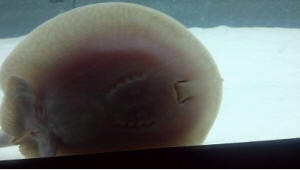
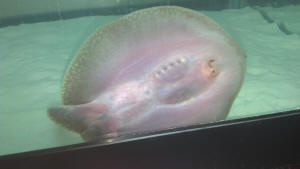
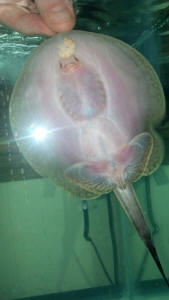 |
|
Question... FW Ray, env. issues 1/14/12
Hello again my favorite fish people!
<If we were faves, why would you clog our email w/ order of
magnitude images, against our policy?>
Just wanted to see if you can identify what my rays skin problem
or at least try to . I sent a couple of pictures . OK first the
ray is eating well like always. The tank setup is a 120
gal
<Stop. Too small.>
with two hang on filters and a EHEIM professional 3 canister
filter the water readings are as follow Ammonia 0 Nitrite 0
Nitrate 30 PH 7.6. Notice the skin problem in
one spot where she had some sand on her so I tested the water to
make sure all is well with Ammonia and Nitrite all was good. Then
it went away. All of a sudden when it was feeding time I notice
that is was all over most of her body. Not sure what it is she is
breathing fine, eating. The larger male does not show any signs
of these marks on his body. The sand has been in this tank for
about 4 years as well as the larger male. Female is about 1 year
and has not shown any signs of distress. Hope you guys can help
me out on this one. Thanks once again.
Maria
<Read here: http://www.wetwebmedia.com/FWSubWebIndex/fwraysysfaqs.htm
and ALL the linked files above. Bob Fenner>
Re: Question
Sorry I didn't know about your policy of the pictures.
<Can't miss it... It's right before where folks find
how to write us:
http://www.wetwebmedia.com/WWMAdminSubWebIndex/question_page.htm
B>
|
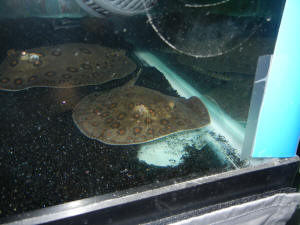 |
|
Sick Marbled Motoro Stingray - White
blotches/covering on skin 5/17/11
Guys,
<Esteban>
First of all, thanks in-advance for your feedback. A synopsis of
my set-up
is as follows:
240 gallon freshwater tank
2 x Fluval FX5 Canister Filters
1 x Large Airstone/Pump
PH = 5.8 to 6.0
<Mmm, too low to suit me... I'd hedge about mid 6>
Nitrite = 0
Nitrate = 100
<MUCH too high. The likely related source of trouble
here>
GH = 180
KH = 160
Temp = 80 degrees
Substrate = Tahitian Moon Black Sand
Inhabitants = Large Royal Marbled Motoro (16 inches) - 3 x Medium
Discus (4 inches)- 3 x Medium Clown Loaches (5 inches)
I have just returned from a business trip and noticed that one of
the Fluval FX5 filters had become clogged and stopped working.
This, I believe, caused a major fluctuation in my Nitrates and
they are now reading around 100ppm. I have performed 40% water
changes over the last three days in an attempt to lower the
Nitrates.
<I'd employ other means on a continuous basis. Please read
here:
http://wetwebmedia.com/FWSubWebIndex/fwnitrates.htm
and the linked files above re NO3>
For my water changes, I have divided a 125 gallon tank into a
water change side (approximately 90 gallons) and a quarantine
side (approximately 35 gallons). The water change side of the
tank is using a Fluval 405 with the same media as the primary
tank (I periodically remove Fluval BioMax from one of the primary
FX5 filters to seed the Fluval 405 filter for water changes). I
also treat the water being used for changes with Discus Buffer to
lower the PH and soften the water before performing water changes
on my primary tank. This cycles for around two weeks at a time
before I perform 30% water changes bi-weekly.
<Reads as a very nice arrangement>
Now for the problem, I awoke this morning and my stingray is
covered with white blotches that were not there the evening prior
(see attached pictures). Could this be due to the increased
Nitrate levels in the tank?
<Yes>
She (the stingray) has not eaten for two days and I assume it is
because of the elevated Nitrates in the tank making her unhappy,
but I am unsure about the white blotches. None of the Discus or
Clown Loaches are showing any signs of stress/white blotches/etc.
and are still eating fine.
<Have different tolerances>
The stingray is inactive and is just lifting the front of its
disk and staying fairly stationary in the tank. Does anyone know
what these white blotches are and how I can heal my favorite
pet?
<Improve its world>
I plan to continue to perform water changes to lower the Nitrates
back to an acceptable level and have also dosed the system with
Amquel Plus to assist with de-chlorinating the new water being
used in the water changes and lower the Nitrates. Any other
suggestions to get the Nitrates down quickly (and safely)?
<See the above reading>
I feed the stingray blood worm cubes, silversides, and shrimp and
use Mazuri Vita-Zu Shark and Ray vitamins at each feeding
(stuffed into a piece of shrimp). There is never food left in the
tank after each feeding. I have had the Royal Motoro Stingray for
approximately 3 years and have had no problems or issues. She is
always active and eating incredibly well (until now).
<Mmm, do add to the alkaline reserve, boosting pH as
mentioned... this will encourage denitrification moderately as
well>
On a side note, I just purchased the Aquaripure Nitrate Filter
and am eagerly awaiting its arrival to set-up on the tank. This
will help in the long-run, but will not do anything to reduce the
Nitrates until the unit is cycled properly (2-4 weeks).
<In the meanwhile, be very conservative re
food/feeding>
I would greatly appreciate any assistance that you could
offer.
Thanks,
Steve
<Welcome. Bob Fenner>
|
|
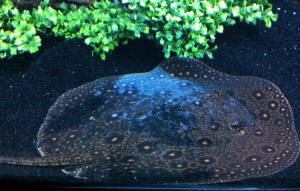
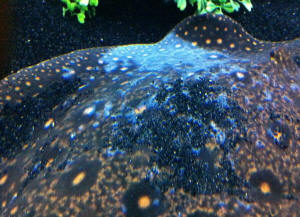
|
Re: Sick Marbled Motoro Stingray - White
blotches/covering on skin 5/17/11
Bob,
<Steven>
First of all, thank you for the fast response. I am panicking a bit
right now and do not want to lose my Motoro or Discus. A couple
things based on your response.......
1. Do you recommend any other way to reduce Nitrates in an
emergency situation (except water changes) (i.e. chemical
additives)?
<Only in very/real dire circumstances... which this very likely
is not. My far fave is AZ-NO3... very effective, safe>
Due to the large volume of water in the tank, I believe it will
take quite awhile to get the Nitrates down doing 40% water
changes.
<Mmm, not so... unless something is adding to the situation,
they should go down tens of ppm w/ each change. You are vacuuming
the substrate?>
I only need something to do as an emergency measure and will follow
the suggestions/recommendations contained within your link moving
forward. I am also hoping that this Aquaripure Nitrate Filter will
help long-term.
The reviews of the system seem positive, but only time will tell.
:) Have you heard anything about this particular filter?
<Mmm, not really. Have just looked: http://aquaripure.com/
My long-experience (our corporation tried to engineer/make these at
one time... with these anaerobe fed (sugar or alcohol) units is
that they are unreliable... too prone to "crashing",
usually w/o too tremendous negative consequences... but you'll
likely "see", be able to report much more re in the
not-too-distant future>
2. PH levels - I agree with you and want the PH to hedge around
6.5, but I believe the increased Nitrates are causing the PH to
drop.
<To some degree, yes>
I have a Milwaukee PH probe on the system that allows me to keep a
very close eye on any fluctuations.
<Good... restrict such change to no more than 0.1 pH point in a
given day if possible>
3. Do you feel that it is Ok to continue to use the Amquel Plus to
assist with lowering the Nitrates?
<Mmm, it really doesn't do this. If you'd like we can
discuss some of the chemistry here>
I really hate using chemicals in my tanks.
4. Should I add anything else to the water to help the stingray
while I am improving her world (i.e. stress coat, etc.)?
<Mmm, I would not... unless you don't/can't trust the
new/make-up/replacement water>
Thanks again as I appreciate your knowledge to help me get through
this nightmare. :)
<Am very glad to assist you, help ease your mind. Usually I
would wait, have Neale Monks respond, as he is far better versed...
but he's presently quite busy teaching in the UK, and
felt/sensed it was important to reply soon/er>
Regards,
Steve
<And you, BobF>
Re: Sick Marbled Motoro Stingray - White blotches/covering
on skin 5/17/11
Bob,
<Mr. Smith>
How do we define dire situation? :)
<Behavioral anomalies... more than static appearances>
The white blotches are quite scary. I only have about 1-2 inches of
sand in the bottom of the tank and typically don't need to
vacuum as the stingray usually stirs the substrate constantly as it
searches for food.
<I WOULD vacuum half of the tank each change-out session... left
or right, the other half next time>
I was under the impression that messing with the substrate could
actually cause my Nitrates to spike?
<A matter of degree... IF there is a "good deal" of
"mulm/detritus" accumulated there, much MORE NO3 will be
expressed than just a "modicum" amount. Put another way,
there can be too little to too much material trapped in ones
substrate>
Reference PH fluctuations, I guess I need to be really careful
given the weakened condition of the stingray. I typically see a PH
fluctuation/increase of around .5 whenever I do a large water
change (+/- 40%).
<This is WAY too much vacillation... am sure you understand the
pH scale is a base 10 log... Human blood pH range is much
smaller... you and I would be dead>
Is that too much and should I decrease the quantity of the changed
water?
<Is and not the quantity, but its quality... should be nudged a
tenth higher pH point...>
I've attached a couple pics of my two tanks...........240
gallon Stingray/Discus and 150 gallon planted Freshwater.
Steve
<Ah, very nice. Bob Fenner> |
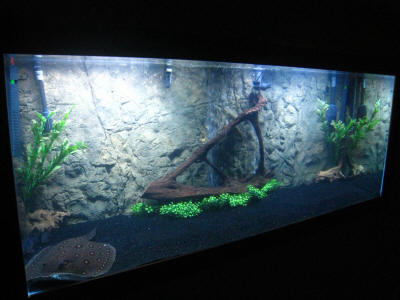

|
Re: Sick Marbled Motoro Stingray
- White blotches/covering on skin 5/18/11
Bob,
<Steve, am also sending you a note/email re your
situation from Neale Monks of WWM... after this>
I hope I am not being a bother, but I have a new
development. The white blotches seem to be shedding
off?
<Yes; not surprisingly>
One of the Discus is also eating the shed skin off the back
of the ray?
<Yes, is their nature>
The skin underneath is a bit lighter, but otherwise looks
healthy (see attached). Tested the tank earlier and reading
80ppm Nitrates.
<Keep changing the water, stop feeding
altogether...>
I am in the middle of another 40% water change right now,
but it seems to be working. Should I add some slime coat
regen after the water change to help with healing?
<I would not. This addition may well only add to
problems here. I WOULD start adding the baking soda... DO
read here: http://wetwebmedia.com/FWSubWebIndex/fwstingrays.htm
AND the related FAQs linked above, particularly Systems...
and in turn elsewhere on WWM re water quality, substrate
issues...>
Thanks,
Steve
<Hang in there... you're doing what best can be
done... in an orderly, appropriate manner. B>
Sick Marbled Motoro Stingray - White
blotches/covering on skin 5/17/11
> Hello Bob,
<Ave Neale>
> I do think you're spot-on about the water quality
issues harming this stingray. Also, the low pH is certainly
reducing the functioning of filter bacteria, which do best
above pH 7.0, so unless there's a damn good reason to
do otherwise, this aquarist should be keeping the stingray
in slightly soft to medium hardness, around neutral water.
But I'd add one more thing.
The Tahitian moon sand is a glass byproduct, not a natural
sand.
<Yes... not benefitting water quality in the
slightest>
It is notoriously abrasive. I wouldn't use it with any
fish that habitually sits on the substrate, and Carib Sea
notably recommends the same thing. There's some debate
among aquarists whether no substrate or a smooth silica
sand/very fine gravel substrate is better, but either way,
you want to minimise physical damage while also ensuring no
organic debris settles on the substrate and starts
rotting.
<Ahh, will post, share w/ the querior should he write
back in. Had thought to have the writer read through our
Potamotrygonids area re this and a few other key items, but
sensed/thought he was already a bit overwhelmed. Thank you,
BobF>
> Cheers, Neale
|
|
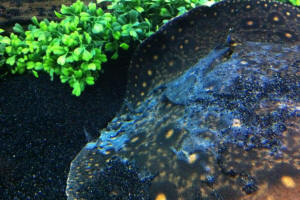
|
|
|
|

